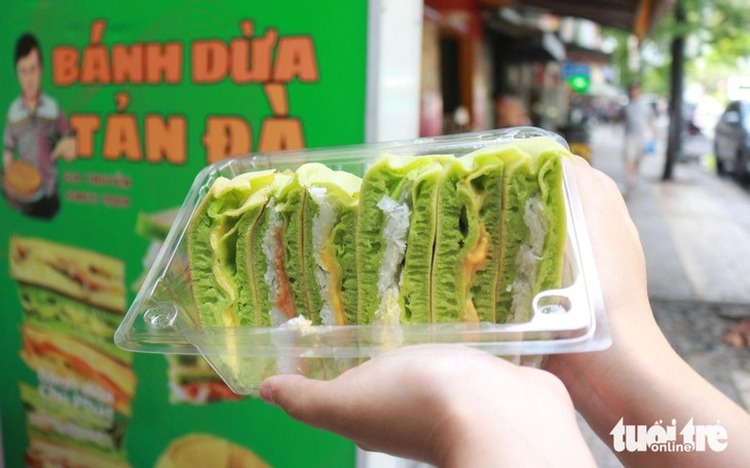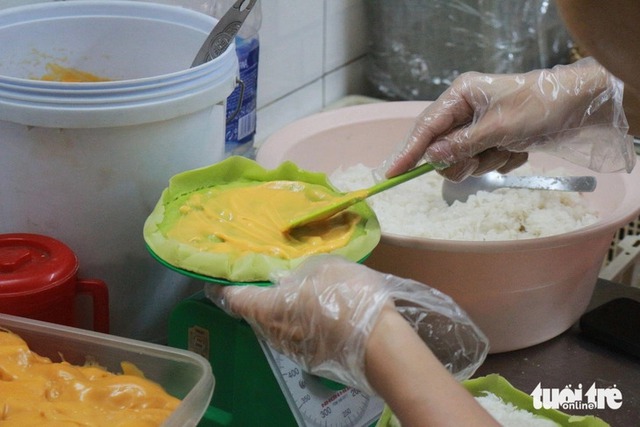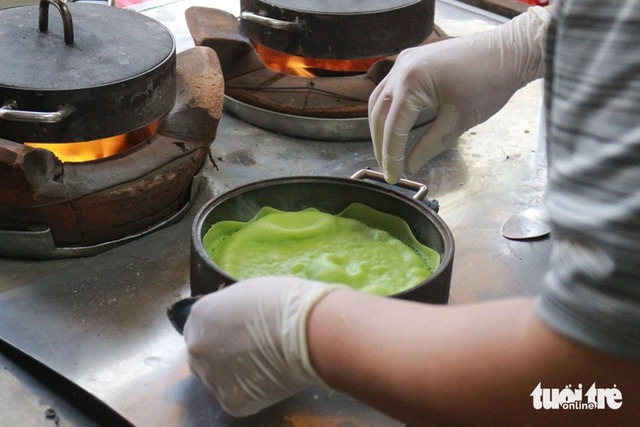
A box of ‘mixed flavors’ Tan Da coconut cakes sells for VND60,000 (US$2.3). Photo: Tu Thanh / Tuoi Tre
The bakery is run by Phat, a Teochew Chinese. In the early days, he would stop along Tan Da Street in the ward until his cakes were sold out.
"People got used to it and started calling them ‘Tan Da coconut cakes,' and the name just stuck," said Hoang, Phat's grandson.
For the past 45 years, the humble cake has become part of the memories of generations of Saigon (the old name of Ho Chi Minh City) residents, especially those who grew up in the bustling Chinese-Vietnamese community there.
Learning through family ties
Phat learned to make coconut cakes from his brother-in-law.
At first, he helped out at the stall, and once familiar with the craft, he began pushing his cake cart through city alleys on his own.

The bakery opened in 1980, starting from Phat’s small pushcart. Photo: Supplied
Customers can choose between two types of outer layer: the golden egg yolk variety or the pandan-flavored green version.
The golden layer is the traditional recipe from when the bakery first opened.
"Sometimes, long-time customers ask for the traditional one to relive the old taste," said Hoang.
Today, most customers prefer the pandan version.
The cake has a delicate, soft exterior and a fragrant, smooth interior with the aroma of eggs and milk.
A bite offers a rich, creamy taste complemented by the playful texture of caramelized coconut.
Alongside the traditional coconut filling, the bakery offers four other varieties, including a mixed-flavor box.
A set of six pieces costs VND40,000-60,000 (US$1.53-$2.3) depending on the filling.
The cakes used to be sweeter, but the recipe has since been adjusted to suit modern tastes while preserving the signature Teochew coconut flavor.

All the fillings are made by family members themselves. Photo: Tu Thanh
The durian-coconut filling is aromatic and rich, with ripe durian blending into the nutty coconut.
The peanut-butter version is slightly salty, balancing the sweetness of the caramelized coconut.
The 'ca dé' filling, a traditional Teochew-style butter-sugar custard, carries a distinct, creamy Chinese-style flavor, while the butter-sugar filling melts on the tongue with a nostalgic sweetness.
On Google Maps, long-time customer Lai Huy wrote, "Everyone has their youth. The smell of baked cakes and coconut mixed with butter brings me back to the carefree days."
Another customer, Tuan Tran Anh, commented, "The cakes are soft and tasty. I like the mixed box and the coconut-peanut butter ones. Each flavor has its own charm."
Keeping family craft alive
Now that Phat is old, the cake-making has been passed down to his children and grandchildren.
The extended family gathers around the stove each day, with some mixing batter, a few grilling the cakes, and others preparing the coconut filling.
"Out of ten people in the family, six or seven help with the cakes. With everyone lending a hand, the batches come out faster while still keeping the original flavor," Hoang said.
Each morning, the household gets up at 5:00 am to mix the batter and let it rest.
By 7:30 am, they light the charcoal, and by 8:00 am, the first batch of cakes is out of the mold, filling the street with a rich aroma.

Freshly baked cakes are soft and airy with a pandan aroma. Photo: Tu Thanh
The Tan Da coconut cake is simple, made from flour, eggs, and sugar poured into cast-iron molds and baked over glowing charcoal.
Producing a good batch, however, is not easy. It requires precision and a few family techniques.
The molds must be heated first so the cakes rise evenly and come out with a smooth shape.
When a batch comes out of the mold, each piece must be removed carefully and set in front of a fan to cool.
"If you spread the filling while the cake is still hot, it tastes great right away, but it turns sour if being kept for too long," Hoang explained.
"Cooling the cakes helps them last longer for customers who take them home."
He added that many loyal customers return, sometimes traveling from far away to buy several boxes at once to keep for later.
Others who live abroad stop by when they visit Vietnam, taking boxes home as gifts to remember the flavors of their childhood.
Amid the city's fast pace, the Tan Da coconut cake shop continues to give off its familiar aroma, a reminder of a slower and more sincere Saigon.


Max: 1500 characters
There are no comments yet. Be the first to comment.